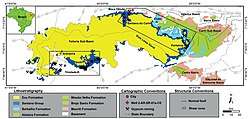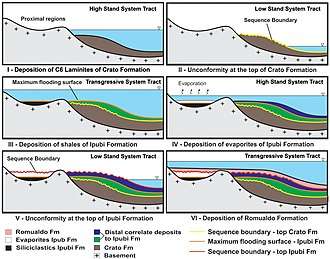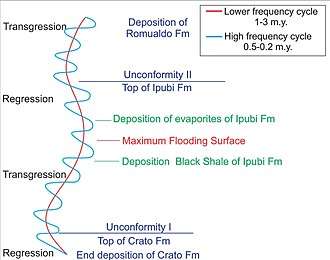Santana Group
The Santana Group is a geologic group, formerly included as the middle part of the Araripe Group, in the Araripe Basin of northeastern Brazil. The group comprises the Crato, Ipubi and Romualdo Formations and is dated to the Aptian to Albian stages of the Early Cretaceous. The formations of the group were deposited in a lacustrine to subtidal shallow marine environment in the Araripe rift basin.[1]
| Santana Group Stratigraphic range: Aptian-Albian ~115–108 Ma | |
|---|---|
 Outcrop of the Santana Group; Ipubi & Romualdo Formations | |
| Type | Group |
| Sub-units | Romualdo, Ipubi & Crato Formations |
| Underlies | Araripina & Exu Formations |
| Overlies | Barbalha Formation |
| Lithology | |
| Primary | Mudstone, sandstone, shale, anhydrite |
| Other | Limestone, marl, siltstone |
| Location | |
| Coordinates | 5.6°S 64.3°W |
| Approximate paleocoordinates | 9.2°S 34.0°W |
| Region | |
| Country | |
| Extent | Araripe Basin |
| Type section | |
| Named for | Santana do Cariri |
 Extent of the Santana Group in blue | |
The Santana Group has provided a rich assemblage of fossils; flora, fish, arthropods insects, turtles, snakes, dinosaurs, such as Irritator, and pterosaurs, among which Thalassodromeus. The stratigraphic units of the group contained several feathers of birds, among those the first record of Mesozoic birds in Brazil. The Romualdo and Crato Formations are renowned for their excellent conservation and designated Lagerstätten. In 2006, the Araripe Basin was designated a UNESCO Global Geopark.
Description
The Santana Group was formerly described as belonging to the Araripe Group.[2] The fossiliferous Santana Formation was previously defined as containing the Crato and Romualdo Members, but redefinition of the stratigraphy led to the establishment of the Santana Group, replacing the middle part of the Araripe Group and the former Crato, Ipubi and Romualdo members were elevated to separate formations.[3][4]
Basin history
The tectono-sedimentary evolution of the Araripe Basin, located in the Borborema Geologic Province, encompasses four stages, with five tectonostratigraphic phases:[5]
1) Syneclise phase - Silurian to Devonian - characterized by tectonic quiescence in the Borborema Province. It is represented by the deposits of the Cariri Formation, that include medium to coarse-grained quartz sandstones, locally conglomeratic, deposited in large braided fluvial systems
2) Pre-rift phase - Tithonian - characterized by the mechanical subsidence due to lithosphere thinning that preceded the rift. It is represented by the Brejo Santo Formation, that comprises red shales and claystones, and the Missão Velha Formation, constituted by medium to coarse-grained quartz-feldspathic sandstones, locally conglomeratic, that contains entire trunks and fragments of silicified wood (Dadoxilon benderi) conifer
3) Rift phase - Berriasian to Hauterivian - characterized by increasing mechanical subsidence that created a system of grabens and half grabens. It is represented by the Abaiara Formation, that includes shales, siltstones, sandstones and conglomerates
4) Post-Rift I phase - Aptian to Albian - characterized by thermal subsidence. The lowermost unit Barbalha Formation, represents a fluviolacustrine phase and is composed of red and gray shales, siltstones and claystones.
The Santana Group was formed during this stage and comprises three stratigraphic units:
- Crato Formation that is composed of six intervals of laminated limestones (C1 to C6), interbedded with calciferous siltstones and marls, and is very rich in fossils of vertebrate and invertebrate organisms
- Ipubi Formation, that is mainly composed of organic-rich, black greenish bituminous shales, claystones and algal limestones that are interbedded with gypsum-anhydrite beds
- Romualdo Formation, that represents a calciferous siliciclastic succession composed of fine to medium-grained sandstones, argillaceous siltstones, calciferous shales, and limestones, very rich in fossils. This formation recorded the marine proto-Atlantic incursion that involved the Araripe Basin, and other interior basins and created a large seaway throughout the Borborema Province during the Albian
5) Post-rift II phase - Albian to Cenomanian - characterized by a major sag phase, and is formed by two stratigraphic units:
- Araripina Formation, that occurs in the western region of the basin and is composed by rhythmites and heterolithic layers of reddish, purplish and yellowish fine-grained sandstone and mudstone
- Exu Formation, that comprises medium-to coarse grained sandstones, fine grained clayey sandstones and local conglomeratic beds
Fossil content
The upper and lower formations of the group are highly fossiliferous, with mainly insects, amphibians, fish,[6][7] and flora dominating the lower Crato Formation,[8] shrimps (Araripenaeus timidus),[9] and various genera of dinosaurs and fish in the Romualdo Formation.[10][11] A rich assemblage of pterosaur fossils are found in both formations,[12][13] and the Ipubi Formation provided an indeterminate Pelomedusoides turtle.[14]
The Santana Group provided several feathers of birds, among those the first record of Mesozoic birds in Brazil.[15]
Gallery
 Schematic development of the depositional environments
Schematic development of the depositional environments Lake level cyclicity
Lake level cyclicity late Early Cretaceous (105 Ma)
late Early Cretaceous (105 Ma) Fossil feathers and Dastilbe fossil
Fossil feathers and Dastilbe fossil
References
- Santana Group at Fossilworks.org
- Scherer et al., 2013, p.28
- Assine, 1992, p.291
- Fabin et al., 2018, p.2050
- Fabin et al., 2018, pp.2051-2052
- Fara et al., 2005, p.152
- Aparecida et al., 2015, p.25
- Jorge de Lima et al., 2015, p.102
- Pinheiro, 2014, p.4
- Weishampel et al., 2004, pp.563-570
- Cavalcanti Duque & Franca Barreto, 2018, p.9
- Elgin & Frey, 2011
- Martill, 2007, p.895
- Ribeiro Oliveira et al., 2011, p.62
- Prado et al., 2016, p.35
Bibliography
- Aparecida dos Reis Polck, Márcia; Marise Sardenberg Salgado de Carvalho; Raphael Miguel, and Valéria Gallo. 2015. Guia de identificação de peixes fósseis das Formações Crato e Santana da Bacia do Araripe, 1–74. Serviço Geológico do Brasil (CPRM).
- Assine, Mario L. 1992. Análise estratigráfica da Bacia do Araripe, Nordeste do Brasil. Revista Brasileira de Geociências 22. 289–300. Accessed 2018-10-05.
- Cavalcanti Duque, Rudah Ruano, and Alcina Magnólia Franca Barreto. 2018. Novos Sítios Fossilíferos da Formação Romualdo, Cretáceo Inferior, Bacia do Araripe, Exu, Pernambuco, Nordeste do Brasil - New Fossiliferous Sites of the Romualdo Formation, Lower Cretaceous, Araripe Basin, Exu, Pernambuco, Northeast of Brazil. Anuário do Instituto de Geociências, UFRJ 41. 5–14. Accessed 2018-10-06.
- Elgin, Ross A., and Eberhard Frey. 2011. A new ornithocheirid, Barbosania gracilirostris gen. et sp. nov. (Pterosauria, Pterodactyloidea) from the Santana Formation (Cretaceous) of NE Brazil. Swiss Journal of Palaeontology 130. 259. Accessed 2018-10-06.
- Fabin, Carlos E.; Osvaldo J. Correia Filho; Márcio L. Alencar; José A. Barbosa; Tiago S. de Miranda; Virgínio H. Neumann; Igor F. Gomes, and Felipe R. de Santana. 2018. Stratigraphic Relations of the Ipubi Formation: Siliciclastic-Evaporitic Succession of the Araripe Basin. Anais da Academia Brasileira de Ciências 90. 2049–2071. Accessed 2018-10-05.
- Fara, Emmanuel; Antônio Á.F. Saraiva; Díogenes de Almeida Campos; João K.R. Moreira; Daniele de Carvalho Siebra, and Alexander W.A. Kellner. 2005. Controlled excavations in the Romualdo Member of the Santana Formation (Early Cretaceous, Araripe Basin, northeastern Brazil): stratigraphic, palaeoenvironmental and palaeoecological implications. Palaeogeography, Palaeoclimatology, Palaeoecology 218. 145–160. Accessed 2018-10-06.
- Jorge de Lima, Flaviana; Antonio Álamo Feitosa Saraiva, and Juliana Manso Sayão. 2012. Revisão da paleoflora das Formações Missão Velha, Crato e Romualdo, Bacia do Araripe, nordeste do Brasil. Estudos Geológicos 22. 99–115.
- Martill, D.M. 2007. The age of the Cretaceous Santana Formation fossil Konservat Lagerstätte of north-east Brazil: a historical review and an appraisal of the biochronostratigraphic utility of its palaeobiota. Cretaceous Research 28. 895–920. Accessed 2018-10-06.
- Neto, João Adauto; Haydon Mort; Ricardo Pereira; José Barbosa; Virginio Neumann; Walter Vortisch; Osvaldo J. C. Filho; Paulo de A. L. S. Brandão, and José G. A. Pacheco. 2013. Carbonaceous Shales in the Araripe Basin, NE Brazil: A Potential Shale Gas Reservoir, 1–7. AAPG Annual Convention and Exhibition. Accessed 2018-10-05.
- Pinheiro, Allysson P.; Antônio Á.F. Saraiva, and William Santana. 2014. Shrimps from the Santana Group (Cretaceous: Albian): new species (Crustacea: Decapoda: Dendrobranchiata) and new record (Crustacea: Decapoda: Caridea). Anais da Academia Brasileira de Ciências _. 1–8. Accessed 2018-10-06.
- Prado, Gustavo M.E.M.; Guilherme Raffaelli Romero, and Luiz Eduardo Anelli. 2016. New occurrences of fossilized feathers: systematics, taphonomy, and paleoecology of the Santana Formation of the Araripe Basin (Cretaceous), NE, Brazil. PeerJ _. 1–49. Accessed 2018-10-06.
- Ribeiro Oliveira, Gustavo; Antônio Álamo Feitosa Saraiva; Helder de Paula Silva; José Artur Ferreira Gomes de Andrade, and Alexander Wilhelm Armin Kellner. 2011. First turtle from the Ipubi Formation (Early Cretaceous), Santana Group, Araripe Basin, Brazil. Revista Brasileira da Paleontologia 14. 61–66. Accessed 2018-10-05.
- Scherer, C.M.d.S.; E.F. Jardim de Sá; V.C. Córdoba; D.d.C. Sousa; M.M. Aquino, and F.M.C. Cardoso. 2013. Tectono-Stratigraphic evolution of the upper Jurassic-Neocomian rift succession, Araripe Basin, Northeast Brazil. Journal of South American Geosciences _. 1–43. Accessed 2018-10-05.
- Weishampel, David B. et al. 2004. Dinosaur distribution (Early Cretaceous, South America) in: Weishampel, David B.; Dodson, Peter; and Osmólska, Halszka (eds.): The Dinosauria, 563–570. Berkeley: University of California Press. ISBN 0-520-24209-2
Further reading
- Báez, A.M.; G.J.B. Moura, and R.O. Gómez. 2009. Anurans from the Lower Cretaceous Crato Formation of northeastern Brazil: implications for the early divergence of neobatrachians. Cretaceous Research 30. 829–846. Accessed 2018-10-06.
- Bechly, G., and V. N. Makarkin. 2016. A new gigantic lacewing species (Insecta: Neuroptera) from the Lower Cretaceous of Brazil confirms the occurrence of Kalligrammatidae in the Americas. Cretaceous Research 58. 135–140. Accessed 2018-10-06.
- Bétard, François; Jean-Pierre Peulvast; Alexsandra de Oliveira Magalhães; Maria de Lourdes Carvalho Neta, and Francisco Idalecio de Freitas. 2017. Araripe Basin: A Major Geodiversity Hotspot in Brazil. Geoheritage _. 1–18. Accessed 2018-10-06.
- Figueiredo, R.G., and A.W.A. Kellner. 2009. A new crocodylomorph specimen from the Araripe Basin (Crato Member, Santana Formation), northeastern Brazil. Paläontologische Zeitschrift 83. 323–331. Accessed 2018-10-06.
- Leite da Silva, Agnelo, and Virginio Enrique Neumann. 2003. Formação Crato da Bacia do Araripe: um reservatório análogo ao Calcário Trairí (Formação Paracuru), Bacia do Ceará, 1–6. 2o Congresso Brasileiro de P&D em Petróleo & Gás. Accessed 2018-10-06.
- Maisey, J.G.; I. Rutzky; S. Blum, and W. Elvers. 1991. Laboratory Preparation Techniques. In Maisey, j:G. (ed): Santana Fossils: An Illustrated Atlas, 99–103. Tfh Publications Inc.. ISBN 0866225498
- Makarkin, V.N., and F. Menon. 2007. First record of fossil 'rapismatid-like' Ithonidae (Insecta, Neuroptera) from the Lower Cretaceous Crato Formation of Brazil. Cretaceous Research 28. 743–753. Accessed 2018-10-06.
- Martill, David M.; Günter Bechly, and Robert F. Loveridge. 2007. The Crato Fossil Beds of Brazil: Window into an Ancient World, 236. Cambridge University Press. Accessed 2018-10-06. ISBN 978-1-139-46776-6
- Martill, D.M. 2007. The age of the Cretaceous Santana Formation fossil Konservat Lagerstätte of north-east Brazil: a historical review and an appraisal of the biochronostratigraphic utility of its palaeobiota. Cretaceous Research 28. 895–920. Accessed 2018-10-06.
- Myskowiak, J.; D. Huang; D. Azar; C. Cai; R. Garrouste, and A. Nel. 2016. New lacewings (Insecta, Neuroptera, Osmylidae, Nymphidae) from the Lower Cretaceous Burmese amber and Crato Formation in Brazil. Cretaceous Research 59. 214–227. Accessed 2018-10-06.
- Neumann, V.H.; A.G. Borrego; L. Cabrera, and R. Dino. 2003. Organic matter composition and distribution through the Aptian–Albian lacustrine sequences of the Araripe Basin, northeastern Brazil. International Journal of Coal Geology 54. 21–40. Accessed 2018-10-05.
- Salisbury, S.W.; E. Frey; D.M. Martill, and M.C. Buchy. 2003. A new crocodilian from the Lower Cretaceous Crato Formation of north-eastern Brazil. Palaeontographica, Abteilung A 270. 3–47. Accessed 2018-10-06.